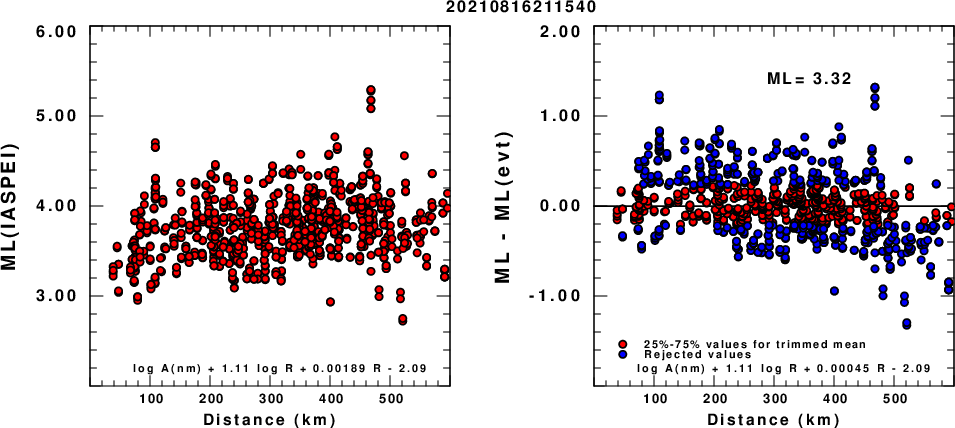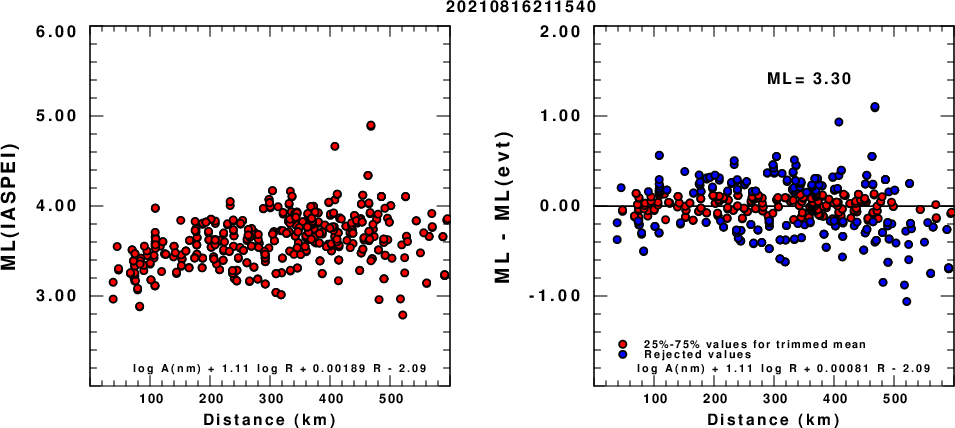Location
Location SLU
2021/08/16 21:15:39.2 45.35N 12.07E H=10.29
The initial waveform inverion using the EMSC solution required sgnificant time shifts that indicated the need that the epicenter was south of the published solution. First motions and arrival tiems ere read and elocate was use to locate the event using the WUS velocity model. After using the SLU epicenter, the first motions were much better fit by the waveform RMT mechanism. The results of the relocation are given in the file elocate.txt.
The RMT solution is supported by the P-wave first motion. The dip-slip nature of the solution was required by the very low excitation of the Love wave signal on the transverse component.
Location ESMC
2021/08/16 21:15:40 47.47 12.05 10.0 4.1
Focal Mechanism
USGS/SLU Moment Tensor Solution
ENS 2021/08/16 21:15:40:0 47.35 12.07 10.3 4.1 Austria
Stations used:
BW.ALFT BW.BE1 BW.BGDS BW.BHG BW.BIB BW.FFB1 BW.FFB2
BW.FFB3 BW.GELB BW.KW1 BW.MGBB BW.MGS01 BW.MGS03 BW.MGS05
BW.PART BW.RJOB BW.RMOA BW.RNON BW.ROTZ BW.RTBE BW.RTSA
BW.RTSH BW.SCE BW.TON BW.UH3 CH.ACB CH.BERNI CH.BNALP
CH.DAVOX CH.EMBD CH.FUORN CH.GRIMS CH.LKBD2 CH.LLS CH.MMK
CH.MUGIO CH.PANIX CH.PLONS CH.SIMPL CH.VDR CH.WGT CZ.CKRC
CZ.NKC CZ.PRU CZ.STAC CZ.TREC CZ.ZVC GE.STU GR.BFO GR.FUR
GR.GEC2 GR.GRA4 GR.GRB1 GR.GRB3 GR.GRB4 GR.GRC1 GR.GRC2
GR.GRC3 GR.GRC4 GR.MILB GR.WET MN.TRI OE.ABTA OE.BIOA
OE.CSNA OE.DAVA OE.FETA OE.KBA OE.LESA OE.MOA OE.MYKA
OE.SOKA OE.SQTA OE.WATA OX.BAD OX.BALD OX.CAE OX.CLUD
OX.FUSE OX.MARN OX.MLN OX.MPRI OX.PRED OX.SABO OX.VARN
SX.TANN TH.GRZ1 TH.PLN TH.RANIS TH.ZEU
Filtering commands used:
cut o DIST/3.3 -30 o DIST/3.3 +70
rtr
taper w 0.1
hp c 0.03 n 3
lp c 0.06 n 3
Best Fitting Double Couple
Mo = 2.85e+21 dyne-cm
Mw = 3.57
Z = 14 km
Plane Strike Dip Rake
NP1 286 81 102
NP2 50 15 35
Principal Axes:
Axis Value Plunge Azimuth
T 2.85e+21 52 210
N 0.00e+00 12 104
P -2.85e+21 35 5
Moment Tensor: (dyne-cm)
Component Value
Mxx -1.08e+21
Mxy 2.98e+20
Mxz -2.53e+21
Myy 2.57e+20
Myz -8.18e+20
Mzz 8.18e+20
--------------
----------------------
-------------- -----------
--------------- P ------------
----------------- --------------
------------------------------------
-------------------------------------#
---------------------------------------#
##########-----------------------------#
###################---------------------##
#########################---------------##
###############################---------##
###################################----###
########################################
############## ####################---
############# T ###################---
############ ##################---
##############################----
##########################----
-######################-----
--##############------
--------------
Global CMT Convention Moment Tensor:
R T P
8.18e+20 -2.53e+21 8.18e+20
-2.53e+21 -1.08e+21 -2.98e+20
8.18e+20 -2.98e+20 2.57e+20
Details of the solution is found at
http://www.eas.slu.edu/eqc/eqc_mt/MECH.NA/20210816211540/index.html
|
Preferred Solution
The preferred solution from an analysis of the surface-wave spectral amplitude radiation pattern, waveform inversion and first motion observations is
STK = 50
DIP = 15
RAKE = 35
MW = 3.57
HS = 14.0
The NDK file is 20210816211540.ndk
The waveform inversion is preferred.
Moment Tensor Comparison
The following compares this source inversion to others
| SLU |
SLUFM |
USGS/SLU Moment Tensor Solution
ENS 2021/08/16 21:15:40:0 47.35 12.07 10.3 4.1 Austria
Stations used:
BW.ALFT BW.BE1 BW.BGDS BW.BHG BW.BIB BW.FFB1 BW.FFB2
BW.FFB3 BW.GELB BW.KW1 BW.MGBB BW.MGS01 BW.MGS03 BW.MGS05
BW.PART BW.RJOB BW.RMOA BW.RNON BW.ROTZ BW.RTBE BW.RTSA
BW.RTSH BW.SCE BW.TON BW.UH3 CH.ACB CH.BERNI CH.BNALP
CH.DAVOX CH.EMBD CH.FUORN CH.GRIMS CH.LKBD2 CH.LLS CH.MMK
CH.MUGIO CH.PANIX CH.PLONS CH.SIMPL CH.VDR CH.WGT CZ.CKRC
CZ.NKC CZ.PRU CZ.STAC CZ.TREC CZ.ZVC GE.STU GR.BFO GR.FUR
GR.GEC2 GR.GRA4 GR.GRB1 GR.GRB3 GR.GRB4 GR.GRC1 GR.GRC2
GR.GRC3 GR.GRC4 GR.MILB GR.WET MN.TRI OE.ABTA OE.BIOA
OE.CSNA OE.DAVA OE.FETA OE.KBA OE.LESA OE.MOA OE.MYKA
OE.SOKA OE.SQTA OE.WATA OX.BAD OX.BALD OX.CAE OX.CLUD
OX.FUSE OX.MARN OX.MLN OX.MPRI OX.PRED OX.SABO OX.VARN
SX.TANN TH.GRZ1 TH.PLN TH.RANIS TH.ZEU
Filtering commands used:
cut o DIST/3.3 -30 o DIST/3.3 +70
rtr
taper w 0.1
hp c 0.03 n 3
lp c 0.06 n 3
Best Fitting Double Couple
Mo = 2.85e+21 dyne-cm
Mw = 3.57
Z = 14 km
Plane Strike Dip Rake
NP1 286 81 102
NP2 50 15 35
Principal Axes:
Axis Value Plunge Azimuth
T 2.85e+21 52 210
N 0.00e+00 12 104
P -2.85e+21 35 5
Moment Tensor: (dyne-cm)
Component Value
Mxx -1.08e+21
Mxy 2.98e+20
Mxz -2.53e+21
Myy 2.57e+20
Myz -8.18e+20
Mzz 8.18e+20
--------------
----------------------
-------------- -----------
--------------- P ------------
----------------- --------------
------------------------------------
-------------------------------------#
---------------------------------------#
##########-----------------------------#
###################---------------------##
#########################---------------##
###############################---------##
###################################----###
########################################
############## ####################---
############# T ###################---
############ ##################---
##############################----
##########################----
-######################-----
--##############------
--------------
Global CMT Convention Moment Tensor:
R T P
8.18e+20 -2.53e+21 8.18e+20
-2.53e+21 -1.08e+21 -2.98e+20
8.18e+20 -2.98e+20 2.57e+20
Details of the solution is found at
http://www.eas.slu.edu/eqc/eqc_mt/MECH.NA/20210816211540/index.html
|

First motions and takeoff angles from an elocate run.
|
Magnitudes
ML Magnitude

(a) ML computed using the IASPEI formula for Horizontal components; (b) ML residuals computed using a modified IASPEI formula that accounts for path specific attenuation; the values used for the trimmed mean are indicated. The ML relation used for each figure is given at the bottom of each plot.

(a) ML computed using the IASPEI formula for Vertical components (research); (b) ML residuals computed using a modified IASPEI formula that accounts for path specific attenuation; the values used for the trimmed mean are indicated. The ML relation used for each figure is given at the bottom of each plot.
Context
The next figure presents the focal mechanism for this earthquake (red) in the context of other events (blue) in the SLU Moment Tensor Catalog which are within ± 0.5 degrees of the new event. This comparison is shown in the left panel of the figure. The right panel shows the inferred direction of maximum compressive stress and the type of faulting (green is strike-slip, red is normal, blue is thrust; oblique is shown by a combination of colors).
Waveform Inversion
The focal mechanism was determined using broadband seismic waveforms. The location of the event and the
and stations used for the waveform inversion are shown in the next figure.

|
|
Location of broadband stations used for waveform inversion
|
The program wvfgrd96 was used with good traces observed at short distance to determine the focal mechanism, depth and seismic moment. This technique requires a high quality signal and well determined velocity model for the Green functions. To the extent that these are the quality data, this type of mechanism should be preferred over the radiation pattern technique which requires the separate step of defining the pressure and tension quadrants and the correct strike.
The observed and predicted traces are filtered using the following gsac commands:
cut o DIST/3.3 -30 o DIST/3.3 +70
rtr
taper w 0.1
hp c 0.03 n 3
lp c 0.06 n 3
The results of this grid search from 0.5 to 19 km depth are as follow:
DEPTH STK DIP RAKE MW FIT
WVFGRD96 1.0 275 45 90 3.31 0.3929
WVFGRD96 2.0 95 45 90 3.41 0.4697
WVFGRD96 3.0 275 30 90 3.45 0.3443
WVFGRD96 4.0 50 20 40 3.48 0.3448
WVFGRD96 5.0 55 15 40 3.49 0.4053
WVFGRD96 6.0 50 15 35 3.49 0.4579
WVFGRD96 7.0 50 15 35 3.48 0.4963
WVFGRD96 8.0 55 15 40 3.56 0.5265
WVFGRD96 9.0 55 15 40 3.56 0.5577
WVFGRD96 10.0 55 15 40 3.56 0.5797
WVFGRD96 11.0 55 15 40 3.56 0.5954
WVFGRD96 12.0 50 15 35 3.56 0.6054
WVFGRD96 13.0 55 15 40 3.57 0.6114
WVFGRD96 14.0 50 15 35 3.57 0.6136
WVFGRD96 15.0 50 15 35 3.57 0.6125
WVFGRD96 16.0 45 15 30 3.58 0.6090
WVFGRD96 17.0 105 75 -85 3.58 0.6040
WVFGRD96 18.0 105 70 -85 3.59 0.6008
WVFGRD96 19.0 105 70 -85 3.59 0.5964
WVFGRD96 20.0 100 65 -80 3.60 0.5905
WVFGRD96 21.0 100 65 -80 3.62 0.5822
WVFGRD96 22.0 105 65 -80 3.62 0.5748
WVFGRD96 23.0 105 65 -80 3.62 0.5666
WVFGRD96 24.0 105 65 -80 3.63 0.5576
WVFGRD96 25.0 105 65 -80 3.63 0.5478
WVFGRD96 26.0 105 65 -80 3.64 0.5374
WVFGRD96 27.0 105 65 -80 3.64 0.5265
WVFGRD96 28.0 105 65 -80 3.65 0.5151
WVFGRD96 29.0 105 65 -80 3.65 0.5032
The best solution is
WVFGRD96 14.0 50 15 35 3.57 0.6136
The mechanism correspond to the best fit is

|
|
Figure 1. Waveform inversion focal mechanism
|
The best fit as a function of depth is given in the following figure:

|
|
Figure 2. Depth sensitivity for waveform mechanism
|
The comparison of the observed and predicted waveforms is given in the next figure. The red traces are the observed and the blue are the predicted.
Each observed-predicted component is plotted to the same scale and peak amplitudes are indicated by the numbers to the left of each trace. A pair of numbers is given in black at the right of each predicted traces. The upper number it the time shift required for maximum correlation between the observed and predicted traces. This time shift is required because the synthetics are not computed at exactly the same distance as the observed and because the velocity model used in the predictions may not be perfect.
A positive time shift indicates that the prediction is too fast and should be delayed to match the observed trace (shift to the right in this figure). A negative value indicates that the prediction is too slow. The lower number gives the percentage of variance reduction to characterize the individual goodness of fit (100% indicates a perfect fit).
The bandpass filter used in the processing and for the display was
cut o DIST/3.3 -30 o DIST/3.3 +70
rtr
taper w 0.1
hp c 0.03 n 3
lp c 0.06 n 3

|
|
Figure 3. Waveform comparison for selected depth
|

|
|
Focal mechanism sensitivity at the preferred depth. The red color indicates a very good fit to thewavefroms.
Each solution is plotted as a vector at a given value of strike and dip with the angle of the vector representing the rake angle, measured, with respect to the upward vertical (N) in the figure.
|
A check on the assumed source location is possible by looking at the time shifts between the observed and predicted traces. The time shifts for waveform matching arise for several reasons:
- The origin time and epicentral distance are incorrect
- The velocity model used for the inversion is incorrect
- The velocity model used to define the P-arrival time is not the
same as the velocity model used for the waveform inversion
(assuming that the initial trace alignment is based on the
P arrival time)
Assuming only a mislocation, the time shifts are fit to a functional form:
Time_shift = A + B cos Azimuth + C Sin Azimuth
The time shifts for this inversion lead to the next figure:

The derived shift in origin time and epicentral coordinates are given at the bottom of the figure.
Discussion
Acknowledgements
Thanks also to the many seismic network operators whose dedication make this effort possible: University of Nevada Reno, University of Alaska, University of Washington, Oregon State University, University of Utah, Montana Bureas of Mines, UC Berkely, Caltech, UC San Diego, Saint Louis University, University of Memphis, Lamont Doherty Earth Observatory, the Iris stations and the Transportable Array of EarthScope.
Velocity Model
The WUS.model used for the waveform synthetic seismograms and for the surface wave eigenfunctions and dispersion is as follows:
MODEL.01
Model after 8 iterations
ISOTROPIC
KGS
FLAT EARTH
1-D
CONSTANT VELOCITY
LINE08
LINE09
LINE10
LINE11
H(KM) VP(KM/S) VS(KM/S) RHO(GM/CC) QP QS ETAP ETAS FREFP FREFS
1.9000 3.4065 2.0089 2.2150 0.302E-02 0.679E-02 0.00 0.00 1.00 1.00
6.1000 5.5445 3.2953 2.6089 0.349E-02 0.784E-02 0.00 0.00 1.00 1.00
13.0000 6.2708 3.7396 2.7812 0.212E-02 0.476E-02 0.00 0.00 1.00 1.00
19.0000 6.4075 3.7680 2.8223 0.111E-02 0.249E-02 0.00 0.00 1.00 1.00
0.0000 7.9000 4.6200 3.2760 0.164E-10 0.370E-10 0.00 0.00 1.00 1.00
Quality Control
Here we tabulate the reasons for not using certain digital data sets
The following stations did not have a valid response files:
Last Changed Tue Aug 17 11:52:50 CDT 2021









